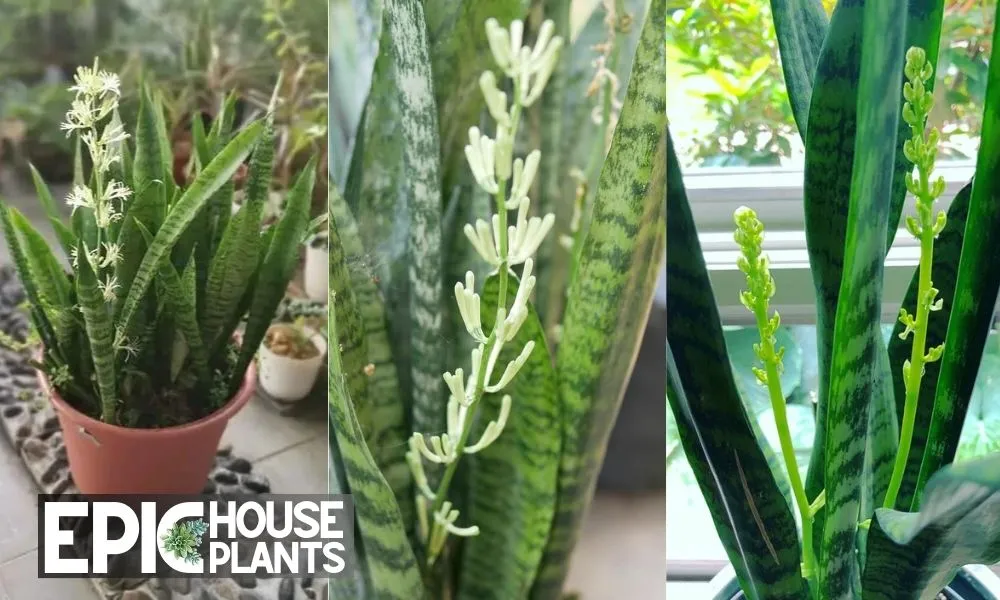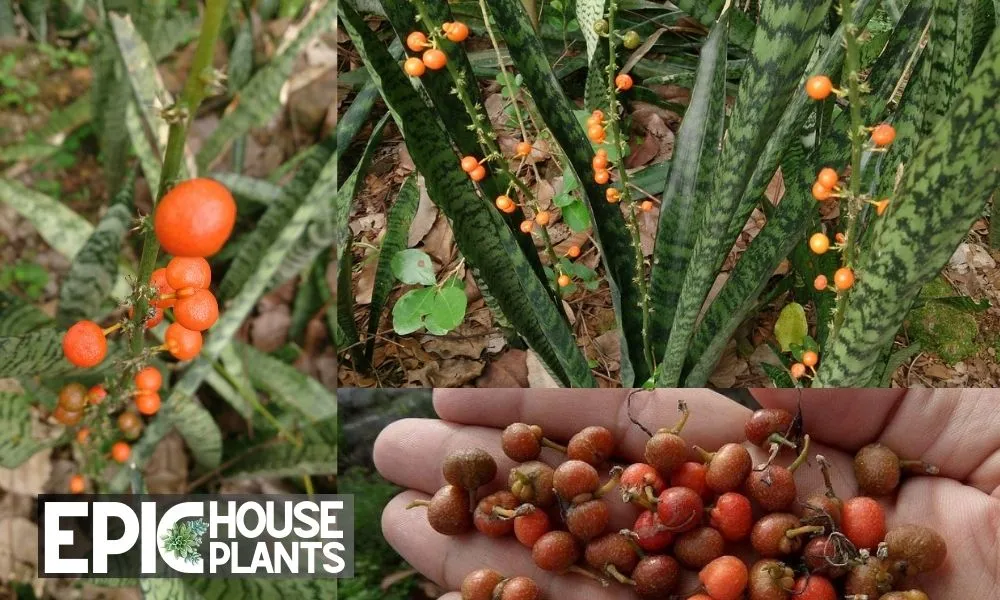Question that often mystifies both the casual observers and indoor gardening enthusiasts alike is: does the snake plant have a flower?
The answer, surprisingly, is Yes. Although it’s a rare occurrence, snake plants can bloom, presenting us with an unexpected and pleasant surprise. Let’s break down the facts and dive into the little-known blooming behavior of the snake plant.

The Surprise of Snake Plant Blossoms
Many snake plant owners may never have witnessed this rare event. Snake plant blooms are somewhat of an anomaly in the indoor gardening world, but when they do occur, they add an enchanting dimension to these already impressive plants.
Typically, the event of a snake plant flowering occurs during the warmer months of spring and summer, adding a seasonal touch to its perennial charm. However, don’t set your calendar to witness this spectacle every year. It’s a rare occurrence, almost as if the plant decides to surprise you when you least expect it.
Snake plants are more likely to bloom when grown outdoors, basking under the natural sunlight and thriving in the elements.
Indoor snake plants, tucked away in corners or standing guard by a window, are less likely to grace us with their flowers. But don’t let this deter you, for when it does happen, it is truly a sight to behold.
Conditions for Snake Plant Blooms
A snake plant will only consider blooming under certain conditions. Think of it as a coming-of-age ritual. Only mature snake plants, typically those more than 3 years old, entertain the possibility of flowering. Youthful plants are more focused on growing taller and stronger, saving their energy for the potential blossoming in the future.
Moreover, blooming is often a result of mild, continuous stress, like when the plant becomes rootbound. This means the plant’s roots have filled up the entire pot, causing stress due to the lack of space.
It’s as if the snake plant, feeling its growth constrained, makes a bid for propagation by producing flowers and seeds.
Author Note:
The ‘stress’ signals to the plant that it’s time to reproduce, leading to the creation of flowers. But remember, the balance is key. Too much stress can harm the plant, but a bit of root pressure may result in a beautiful surprise.
How often do snake plants bloom?
As for the question of how often snake plants bloom, there’s no set frequency. Some plants may surprise you with yearly blooms, while others might take years between flowering events. There’s a touch of unpredictability, which makes their blooming all the more special
Snake plant blossoms don’t rush; they relish in their own time. Once bloomed, these flowers can last anywhere from 2 to 4 weeks, offering you a generous window to enjoy their beauty and fragrance.
The Beauty of Snake Plant Flowers
Now, let’s try to imagine the flower of a snake plant. Picture a delicate, sweetly fragrant blossom, quite a contrast to the bold and strong leaves that snake plants are known for.
Each flower is a small, tubular structure, usually off-white or pale green, blooming in clusters on a long, slender stalk called an inflorescence. They are subtle yet captivating, a paradoxical expression from a plant known more for its toughness than its softness.
The flowering of a snake plant is a gentle reminder of the extraordinary wonders of nature, even in the most familiar of spaces. It illustrates that patience and persistence, just like for our snake plant, often lead to beautiful results.
The Enchanting Aroma of Snake Plant Flowers
But the beauty of the Snake Plant flower goes beyond the visual. These little wonders are not just treats for the eyes; they enchant the senses with an olfactory symphony that is as sweet as it is soothing.
When the time is right, the Snake Plant flowers unfurl their fragrant secret. They emit a unique aroma, a spicy yet sweet scent, bearing striking similarities to vanilla, that fills the air subtly, yet persistently.
How to Get a Snake Plant to Bloom
While there’s no foolproof formula to trigger snake plants to flower, certain factors can influence their propensity to bloom.
The Prerequisite: Mature Plants
Just as wisdom is often associated with age, so too is the snake plant’s ability to bloom. Young snake plants typically do not flower. Instead, they invest their energy in growing taller and stronger.
However, once a snake plant reaches peak maturity – which usually takes 3 years or more – it is capable of producing those elusive, sweet-scented flowers.
The Power of Confinement: Root-bound Stage
Snake plants have a peculiar tendency: they are more likely to bloom when their roots are somewhat confined.
This state, referred to as being ‘root-bound’, occurs when the roots of the plant fill the pot, leaving little room for further growth. You can encourage a root-bound state by refraining from repotting your snake plant for a couple of years.
Sunbathing: A Crucial Factor
Snake plants, despite their tolerance for low light conditions, are more likely to bloom when they receive a generous dose of sunlight. If possible, keep your snake plant outdoors where it can bask in the glory of natural light.
If this isn’t feasible, place it near a window that receives direct sunlight. A minimum of 3-4 hours of direct sun each day can significantly influence your snake plant’s willingness to flower.
Strategic Stress: Lacking Nutrients
Contrary to most plants, snake plants may be nudged into blooming when they’re slightly stressed.
This stress can be induced by avoiding the application of fertilizers, thereby making your plant slightly nutrient-deficient. However, remember to maintain a balance – too much stress might adversely affect your plant’s health.
Watering Wisdom: Striking a Balance
As for watering, less is more when it comes to snake plants. It’s best to water them only when the soil is completely dry. Overwatering can be detrimental to these drought-tolerant plants.
That said, an extremely long duration without watering can put the plant’s survival at stake. Thus, finding a balance is key.
The Fruity Revelation: Snake Plant Berries

After blooming, some snake plant flowers may take another surprising turn – they can produce berries, which contain seeds. Not every flower will morph into a fruit; only those that have been pollinated have this potential.
Snake plant berries are small, usually ranging from a quarter to half an inch wide. They can be a bright, eye-catching orange or a more subdued dark brown, depending on the species. While intriguing, these berries should be handled with care as they are toxic to both humans and pets.
If you’re keen on propagating your snake plant, you can use these seeds. However, be aware that snake plants grown from seeds may lose their variegation, resulting in a more uniform green coloration instead of the distinct patterns we often associate with snake plants.
The Self-Pollination Marvel of Snake Plants
Nature has designed snake plants with an intriguing capability – they can self-pollinate. This means some of their flowers, instead of merely fading away, can morph into orange berries. This transformation is more common in outdoor snake plants, where insects and other natural pollinators can lend a helping hand. However, it’s not entirely unheard of for indoor snake plants to produce berries as well.
Each berry that your snake plant produces is a mini treasure chest, containing one or two seeds that can give rise to new snake plants.
DIY Pollination: Ensuring Fruiting Success
If you’re excited by the prospect of your snake plant producing berries and can’t leave it to chance, there’s good news: you can pollinate the plant yourself! This hands-on approach can increase the likelihood of your snake plant flowering and subsequently bearing fruit.
Here’s how you can do it:
First, identify a flower that you’re willing to sacrifice for the cause. Once selected, snip or pinch off this flower. This flower is your pollen donor. The pollen-bearing parts, known as the stamens, are your primary focus here.
Next, take the stamens of the snipped flower and brush them gently against another flower in bloom. This second flower is your pollen recipient. The pollen from the donor flower’s stamens will be transferred to the recipient flower, thus aiding pollination.
Do remember to approach this process delicately. The flowers of snake plants are subtle and need to be handled with care.
FAQs
Is it Bad if a Snake Plant Flowers?
No, it’s not bad. Although flowering is triggered by stress and is a shift in resource allocation, it does not harm the snake plant.
Many snake plant owners express surprise – and sometimes concern – when their plant flowers. After all, the occurrence is quite rare, and often triggered by the plant experiencing some level of stress.
During such times, the snake plant redirects its resources from growing new foliage to producing delicate, fragrant blooms. This shift is geared towards the ultimate goal of reproduction, with the hope of producing seeds.
Does a Snake Plant Die After Flowering?
No, snake plants don’t die after flowering. Each rosette can produce a flower spike once, after which it doesn’t grow new foliage but remains alive for years. New rhizomes from the root mass can grow into new rosettes that may bloom.
Unlike some plants that are ‘monocarpic’ – dying after they flower once – snake plants adopt a middle ground. They are neither monocarpic nor ‘polycarpic’ (capable of flowering multiple times).
After blooming, it doesn’t grow new foliage. However, it doesn’t die either. The existing leaves remain healthy and vibrant for years to come.
Do Snake Plant Flowers Produce Seeds?
Yes, but not always. Only pollinated flowers produce berries containing one or two seeds. These berries can be toxic to humans and pets. Snake plants grown from seeds might lose their variegation.
Final Words
If you’re fortunate enough to have your snake plant bloom, consider yourself part of an exclusive club. It’s a rare, delightful surprise that adds a magical touch to your indoor or outdoor garden.
And if your snake plant hasn’t blossomed yet, don’t worry. Keep providing it with the love and care it needs, and perhaps one day, it will reveal its lovely secret to you.
Author

Pudji Haryanto
Pudji Haryanto is a writer and urban farmer with a passion for cultivating plants. He has over 15 years of experience in agriculture and currently manages a 65,000 square foot rice-field and yard filled with various plants, including vegetables, spices, flowers, and garden plants.


